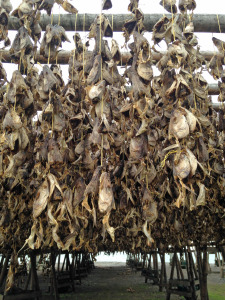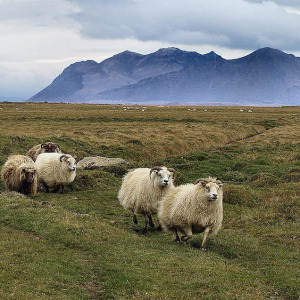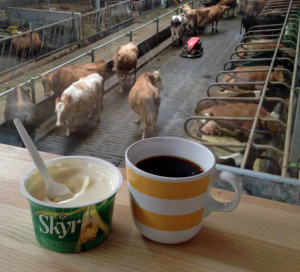By Megan Myrdal, RDN
Located at the juncture of the North Atlantic and Arctic oceans, Iceland is a rugged, awe-inspiring country, filled with warm, welcoming people, rich culture, and a raw, untouched landscape unlike anywhere else on earth.
I traveled there last summer as part of a program to discover my heritage (my great, great grandparents immigrated from Iceland to America in the late 19th century), and experience this amazing country and its people. During my stay, I learned a great deal about Icelandic history, and was especially drawn to the food history, which includes centuries of fishing, farming, and foraging for survival.
It’s not hard to connect the foods of 21st century Iceland to the country’s origins. When Norse settlers migrated west and discovered Iceland in the 9th century, they brought with them farming practices, food traditions, and centuries of food preservation skills that are still relevant and used today. These traditions have been passed down from generation to generation, and have been used to produce delicious, distinct foods and flavors.
When my great, great grandparents immigrated to North Dakota in the late 19th century, they brought with them many of the food traditions and farming practices used in their homeland. Having the opportunity to see the origins of my families’ strongest food practices was a life-changing experience.
After spending six weeks exploring my ancestor’s roots, four things stand out as iconic of the Icelandic food and culinary culture: fish, lamb, dairy and fruits & vegetables. Together, these foods create a compelling glimpse into a country rich with culinary heritage.
FISH
Fish is a staple of the Icelandic diet, a specialty in many restaurants, and also a major export. The North Atlantic Ocean surrounding Iceland contains rich fishing grounds that provide cod, haddock, halibut, and herring to suit local need. Freshwater fish are also a staple in Icelandic cuisine, and include brown trout, Arctic char (a farmed fish in Iceland and cousin of salmon and trout with a sweet, delicate flavor), and Atlantic salmon. I ate many delicious fish in Iceland, and met many Icelanders who were quick to tell me their favorite type.
This was one of the food traditions I did not grow up with. While Iceland is a fishing hotbed, North Dakota is the most landlocked entity in North America.. Although we have great lakes and rivers for fishing, our family developed a love for hunting wild game, which is abundant in North Dakota, and this practice took the place of our fishing roots.
Harðfiskur, hard fish or dried fish (usually cod or haddock), is a snack time favorite, and originates, like many Icelandic foods, from primitive preserving techniques. The traditional method for creating the hard fish was drying by sun and wind, but today it is mass-produced by fan or oven drying. According to my grandmother, my ancestors dried fish near the ocean, which allowed the salty air to enhance preservation and flavor. I can’t find scientific evidence to support this technique, but found it fascinating and witnessed it while touring northern Iceland. I also ate this salty, crunchy food many times, and grew to enjoy the taste (although the smell while drying is incredibly pungent).

Drying fiskur at the Skagafjordur harbor in Iceland.
LAMB
Iceland sheep, known for their insulating, water-resistant wool used to make the lolapeysa (traditional Icelandic sweater), are the most common farm animal in Iceland, and provide the main source of domestic meat. We saw these animals grazing freely in the mountain and highland areas, eating a diet of grass, wild herbs, and flowers. In the summer months, Iceland has nearly 24 hours of sunlight, increasing feeding time to allow the sheep to get to market weight on a purely pastureland diet. Because of its high quality and distinctive flavor, Icelandic lamb helped spur the country’s infiltration into American food markets when Whole Foods agreed to sell it in 1998.
Hangikjöt, or “hung meat,” is smoked lamb and a traditional Icelandic festive food. Some of my favorite childhood memories include this distinctive meat with its delicious aroma that fills an entire home. It was one of my afi’s (Icelandic word for Grandfather) favorite foods; it was always served at Christmas and other important family events. Hangikjöt is brined and smoked for 2-3 weeks, and its name comes from the old tradition of smoking food by hanging it from the rafters of a smoke shed. The best smoking materials are woods such as birch, willow, or juniper, however, during difficult times in Icelandic history, dried sheep dung was used for smoking fuel. My Afi’s preferred wood was applewood.
Hangikjöt is traditionally served open face on rúgbrauð (rye bread) or laufabrauð (flat bread) with a generous spread of smjor, Icelandic butter with a rich, delicious flavor and buttercup yellow color. This open-faced sandwich is a staple in the Icelandic diet, and can be purchased at most gas or convenience stations as a quick snack or meal.

Icelandic sheep and rural scenery. (Photo credit: flickr.com/photos/atlih/)
DAIRY
Dairy products are very important to the Icelanders and one of the most popular is skyr, a cultured milk similar to yogurt that has been part of the diet for more than 1,000 years. Skyr’s velvety texture, high-protein content, and the variety of flavors available today, have helped this food to remain a staple and delicious part of the Icelandic diet. When my ancestors homesteaded, they brought the skyr making technique with them, and my father recalls his amma and afi spending days in the farmhouse basement making skyr.

A Vanilla Skyr and Coffee at the Kaffi Kú, a coffee shop located above the cowshed at the Garður farm near Akureyri.
FRUITS & VEGETABLES
Iceland’s restricted growing season and cool climate have made it difficult to grow many fruits and vegetables. Root vegetables like potatoes, rutabagas, beets, carrots, and other cold weather produce like cabbage and rhubarb, have long been a part of Icelandic menus and are still commonly eaten today. Icelanders are also known to gather wild berries, including crowberries and blueberries, which are eaten fresh and used to make jams and juices. After immigrating to North Dakota, my ancestors maintained this tradition by foraging for wild juneberries to serve with skyr in their new American homes.
In addition to cool-weather produce, Iceland has captured its geothermal energy to increase its growing abilities with greenhouses. For nearly 100 years, Iceland has been able to grow nearly all its cucumbers, peppers, and tomatoes, and created the home of Europe’s largest banana greenhouse! For real, there’s a whole blog devoted to it here.
There are, of course, many other aspects of Icelandic cuisine and food history that cannot be covered in a short blog. If you’re interested in the country’s food scene and would like to try some experimenting of your own, I recommend North: The New Nordic Cuisine of Iceland by Chef Gunnar Karl Gíslason. It’s filled with amazing recipes from a chef who’s dedicated to breathing new life into old food traditions, and celebrating his country through food.

Chef Gunnar Karl Gislason and Amy Myrdal Miller (November 2012)
I cannot wait to go back to Iceland, to again see the land of fire and ice, meet more interesting people, and get that feeling that words cannot describe but is uniquely Iceland. It’s like no other place on earth, and this small country and its captivating food scene have created a memory that’s wonderful, inspiring, and distinctively Icelandic.

